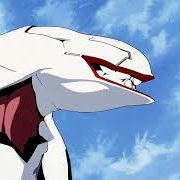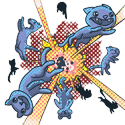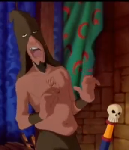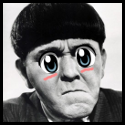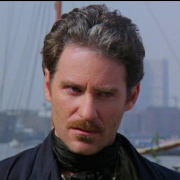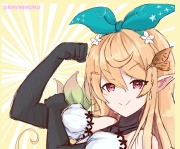|
The "extended universe" is where the reader comes in. Tolkien created such a fantastic world that it feels like you could really just go there and explore. I'm a huge nerd and have a map of middle earth hanging on my wall and sometimes I'll sit back in my chair and look at it and place myself there and in all the various places found there. There's no need for fan fiction when you've got yourself your imagination and a great source of inspiration like Tolkien gave us.
|
|
|
|

|
| # ? May 8, 2024 16:02 |
|
I've been trying for a while to get a handle on how different fictional universes make themselves available to fanfiction writers and Extended Universe type stuff. With Tolkien there seems to be hardly any room to imagine anything from scratch, is there? It's just about all been carefully laid out, year by year, race by race, map by map, so the only things a fan can add to it would be picking a specific well-established time and place and spending some effort fleshing out the details (I've always thought the story of Arvedui might make a good standalone novel). But you compare it to something like, say, Star Wars, which seems like it's at the far opposite end of the spectrum. Not much is specified about it, and what there is is pretty loosely interpretable, yet hints at a much vaster universe than any one movie or trilogy could cover—so you end up with endless novelizations and comics and video games and TV series and so on, much of which contradicts other stuff in the same category. You feel like you could cough wrong and accidentally find a Star Wars fanfic on your desk. I think of these two examples as extremes on a scale. If you think about just about any other fictional universe, like Star Trek or Narnia or Sonic the Hedgehog or The Lion King, they all fit somewhere along that line, and the amount of fanfic they spawn is a good measure of how far toward one end or the other they go.
|
|
|
|
|
I don't agree, I think there's so so many ways people could go. I mean the universe spans tens of thousands of years, or even hundreds of thousands of years if you look at the years of the pillars/trees. You could, as someone said above, have a story with Bilbo's mom. If that's a bit close to home you could cover the two blue wizards; if that's still a bit too close to home you could just make up some early human in the house of Hador or something going on an adventure. You could have a Dwarf looking to see if there's a heart of the mountain somewhere other than Erebor. You could have some adventurous Numenorean sailing through the Gates of the Sun to see what lies beyond. You could have a Hobbit who gets lost on the wrong side of the hedge. The possibilities are endless.
|
|
|
|
SHISHKABOB posted:The "extended universe" is where the reader comes in. Tolkien created such a fantastic world that it feels like you could really just go there and explore. I'm a huge nerd and have a map of middle earth hanging on my wall and sometimes I'll sit back in my chair and look at it and place myself there and in all the various places found there. This. A thousand times this. Trying to speculate and guess what Tolkien had meant by certain stories in his text and where he would have gone next with his writing is what makes reading great. I'd rather the stories be left how they are than new ones made up or getting what Tolkien intended with his writing wrong and extrapolating from there. SHISHKABOB posted:so you end up with endless novelizations and comics and video games and TV series and so on No, that's what happens when you sell out and care more about the money than the story. (Unless the money is the only reason you did it to begin with) The problem with fan-fiction is that if a piece of writing by a fan becomes extremely popular it can often get taken as canon or people assume that because the fan did proper research and fleshed out existing writing then this is what the original author would have intended. Fan-fiction revolving around new characters in the universe (Who play no real part in the events of the main storylines) are great. They don't affect the original prose and are often a great read if you are looking for something loosely based around a universe you enjoy reading about. Catsplosion fucked around with this message at 14:40 on Jan 1, 2014 |
|
|
concerned mom posted:I don't agree, I think there's so so many ways people could go. I mean the universe spans tens of thousands of years, or even hundreds of thousands of years if you look at the years of the pillars/trees. You could, as someone said above, have a story with Bilbo's mom. If that's a bit close to home you could cover the two blue wizards; if that's still a bit too close to home you could just make up some early human in the house of Hador or something going on an adventure. You could have a Dwarf looking to see if there's a heart of the mountain somewhere other than Erebor. You could have some adventurous Numenorean sailing through the Gates of the Sun to see what lies beyond. You could have a Hobbit who gets lost on the wrong side of the hedge. The possibilities are endless. That may be so, but how much fanwork of Tolkien's stuff is there? I honestly don't know; I haven't looked. But I know I haven't stumbled across any aside from art, whereas other properties are just lousy with it. You don't usually have to dig very hard.
|
|
|
|
|
Catsplosion posted:This. A thousand times this. What about licensed fiction written for the Middle-Earth RPG? I've heard it assumed among some, like video game modders, that their names for the Nazgul sound cool and do not contradict Tolkien, so they should be accepted as the standard. Adûnaphel the Quiet Akhôrahil the Blind Sorceror!
|
|
|
|
William Bear posted:What about licensed fiction written for the Middle-Earth RPG? I've heard it assumed among some, like video game modders, that their names for the Nazgul sound cool and do not contradict Tolkien, so they should be accepted as the standard. I first encountered those names in The Wizards CCG and am completely in love with them. Khamul the Easterling, Uvatha the Horseman, Ren the Unclean! Not canon but pretty close in my book.
|
|
|
|
Oh, I hope there's one Nazgûl who's kind of a spaz and the others put up with him because of fraternal duty or Sauron's orders or something, but secretly despise him and make fun of him behind his back. Mûn Mûn
|
|
|
|
|
Well, Khamûl the Shadow of the East isn't made up at least
|
|
|
|
I'm fine with any that are in Tolkiens works or implied (Being one of the human kings that was given a ring of power for instance) but otherwise I'm against it. You can't assume that the writer, in this case Tolkien, would have used those names just because they sound 'right' or cool. Fan-fiction should never be canon because by definition it isn't. Tolkien could have great lore plans for all of the nazgul, and huge side stories for each, who knows? Isn't the part of the fun speculating what could be? and not trying to defining something as canon which can never be. Catsplosion fucked around with this message at 16:47 on Jan 12, 2014 |
|
|
|
pixelbaron posted:Well, Khamûl the Shadow of the East isn't made up at least Where does information on Khamûl show up? I hear its the only one of the ringwraiths who was named by Tolkien.
|
|
|
|
According to my Complete Guide to Middle Earth, none of the Nazgul are ever named. Though it says it's possible that Gothmog was the 2nd in command Nazgul.
|
|
|
|
Gothmog is named as The Lord of the Nazgul's lieutenant in The Return of the King. Most commentary I've seen interprets this as one of the Nazgul, though it is not explicitly stated as such. Gothmog's fate is not known, unless he is assumed to have been one of The Nine.
|
|
|
|
The films (re?)used the name Gothmog for the Orc commander, the one with all the swellings and deformities.
|
|
|
|
Khamul is named in Unfinished Tales. He's the Nazgul who follows Frodo, Sam, and Pippin to Bucklebury Ferry, as I recall.
|
|
|
|
Nevermind.
|
|
|
|
I've always loved LoTR and the Hobbit and am now greatly enjoying reading the Silmarillion for the first time. Now I was looking to purchase the Unfinished Tales and the children of Hurin, but some people on Amazon are saying the story in Hurin is also in Unfinished Tales word for word. Is this nonsense?
James The 1st fucked around with this message at 03:13 on Jan 12, 2014 |
|
|
|
James The 1st posted:I've always loved LoTR and the Hobbit and am now greatly enjoying reading the Silmarillion for the first time. Now I was looking to purchase the Unfinished Tales and the children of Hurin, but some people on Amazon are saying the story in Hurin is also in Unfinished Tales word for word. Is this nonsense? A story of Hurin is in Unfinished Tales, IIRC, but it's not at all the same as Children of Hurin.
|
|
|
|
I think it is also partially in the Silmarillion, but I haven't read it in a while.
|
|
|
|
I thought Gothmog was the leader of the Balrogs back in Melkor's time? I don't recall the name ever being used outside of that context.
|
|
|
|
Viridiant posted:I thought Gothmog was the leader of the Balrogs back in Melkor's time? I don't recall the name ever being used outside of that context. Gothmog is two characters, one from the Silmarilion wich was the lord of the Balrogs as you say and another from the Lord of the rings books. In the LOTR books he is mentioned being second in command after the Witch king, and he takes over the control of the mordor forces when the witch king has been slain at the battle of pelennor fields. It is not mentioned what race he is however.
|
|
|
|
James The 1st posted:I've always loved LoTR and the Hobbit and am now greatly enjoying reading the Silmarillion for the first time. Now I was looking to purchase the Unfinished Tales and the children of Hurin, but some people on Amazon are saying the story in Hurin is also in Unfinished Tales word for word. Is this nonsense? The Silmarillion has a short version of that whole story, which is in actuality editorially cobbled together from older short versions and parts of drafts of the expanded version; Unfinished Tales has some of the latter interspersed with Christopher Tolkien's notes and commentary, skipping some parts of the story that aren't sufficiently different from the Silmarillion version. The version in Children of Húrin is a unified tidied-up narrative. Most of the material in it is included in either Unfinished Tales or the Silmarillion, although not precisely; different drafts/manuscripts were used, Christopher Tolkien wrote a few bridging pieces to connect things together with the parts that were never fully expanded, and so on. Hamiltonian Bicycle fucked around with this message at 11:24 on Jan 12, 2014 |
|
|
|
Hamiltonian Bicycle posted:The Silmarillion has a short version of that whole story, which is in actuality editorially cobbled together from older short versions and parts of drafts of the expanded version; Unfinished Tales has some of the latter interspersed with Christopher Tolkien's notes and commentary, skipping some parts of the story that aren't sufficiently different from the Silmarillion version. The version in Children of Húrin is a unified tidied-up narrative. Most of the material in it is included in either Unfinished Tales or the Silmarillion, although not precisely; different drafts/manuscripts were used, Christopher Tolkien wrote a few bridging pieces to connect things together with the parts that were never fully expanded, and so on. Children of Hurin is a great read. It's more fleshed out and detailed than the truncated version in the Silmarillion, and by no means "unfinished" as the version in Unfinished Tales.
|
|
|
|
Gianthogweed posted:Children of Hurin is a great read. It's more fleshed out and detailed than the truncated version in the Silmarillion, and by no means "unfinished" as the version in Unfinished Tales. Agreed. Children of Hurin audiobook is read by Christopher Lee
|
|
|
|
Hogge Wild posted:Agreed. Children of Hurin audiobook is read by Christopher Lee I didn't know that. I may purchase my first audiobook just for this. On a sort-of related note, the lector at my church sounds a lot like Christopher Lee. Sometimes I inwardly chuckle at the thought of Saruman reading Scripture.
|
|
|
|
I'm relaxing on a friday night watching the Return of the King on blu-ray and man for any faults the movies or the books have, Tolkien's world is awesome and it's amazing to me how much a part of my life it's been  My dad was a big fan and when we'd go backpacking he'd talk about how rock outcroppings reminded him of the trolls turned to stone in the Hobbit, so being out in the wilderness will always remind me of Middle Earth My dad was a big fan and when we'd go backpacking he'd talk about how rock outcroppings reminded him of the trolls turned to stone in the Hobbit, so being out in the wilderness will always remind me of Middle EarthI'm also maybe a huge nerd but whatever
|
|
|
|
If someone was going to do some side story material, I'd say Galadriel would be a good figure for that. Seems like she had an interesting life.
|
|
|
|
|
Nessus posted:If someone was going to do some side story material, I'd say Galadriel would be a good figure for that. Seems like she had an interesting life. Over the last few years, I've come to see Galadriel as the central figure in The history of the western part of Middle a Earth. In many ways she embodies the fall from grace of the Noldor, and their eventual submission to the Valar. I also find it interesting that her symbolic heir left in Middle Earth was Sam, the humblest of the Fellowship by far.
|
|
|
|
There's some more info on her in the Unfinished Tales book
|
|
|
|
I don't know how new this is, but here is illustrations by Evan Palmer of the Ainulindalë from The Silmarillion. Some excerpts:  
|
|
|
|
Oh my god, that art is incredible. In return I give you What Middle-Earth would look like from space.
|
|
|
|
If anyone wants to know what is in Unfinished Tales http://www.ae-lib.org.ua/texts-c/tolkien__unfinished_tales__en.htm Personally I love it for the section on The Istari. It's an invaluable resource for anyone who loves Saruman and he is by far my favorite Tolkien villain. It gives interesting facts that held settle debates such as Sauron vs. Saruman (it was at least kinda arguable based just on the books but UT kinda says point blank Sauron was "mighter than [Saruman]" and it also offers some insight into Saruman's charactr, such as the fact he was constantly being undermined by Gandalf. Varda herself said Olorin (Ganalf) did not go after Saruman, then Gandalf was given the Ring of Fire instead of Saruman, and then Galadriel wanted Gandalf to be head of the White Council. You can see why he was so jealous of the Grey Pilgrim. I loved this alternate take too: quote:In this account, Saruman, in fear and despair, and perceiving the full horror of service to Mordor, resolved suddenly to yield to Gandalf, and to beg for his pardon and help. Temporizing at the Gate, he admitted that he had Gandalf within, and said that he would go and try to discover what he knew; if that were unavailing, he would deliver Gandalf up to them. Then Saruman hastened to the summit of Orthanc - and found Gandalf gone. Away south against the setting moon he saw a great Eagle flying towards Edoras. I like to imagine this is canon. Sorry to gush but Saruman to my eyes is the most three-dimensional antagonist Tolkien ever wrote. I love him so much. (and hate what the movies did to him by making him just Sauron's toady)
|
|
|
|
Radio! posted:Oh my god, that art is incredible. Spend the weekend exploring a simulation of Middle-earth instead of writing essays? Sounds good to me.
|
|
|
|
Seconding the recommendation to read the Unfinished Tales if any of you haven't yet. It's full of really great background information (like the stuff about Saruman) but also is a great insight into the way the history of Middle-Earth changed during Tolkien's lifetime. I know that's technically what the Lost Tales is more supposed to do, but the Middle-Earth in Unfinished Tales is far more recognizable as the same world from LotR than the more primitive versions in the Lost Tales. It's still pretty jarring (in an interesting way!) to read about how something you thought was "fact" was actually completely different in Tolkien's mind, since he altered a lot of things even after LotR was published. Even little things, like how Amroth of the Amroth and Nimrodel story was at one point supposed to be Galadriel's son. Also, goddamn, Aulë must have had some poo poo taste in people to have had both Sauron and Saruman as his household Maiar.
|
|
|
|
Radio! posted:Also, goddamn, Aulë must have had some poo poo taste in people to have had both Sauron and Saruman as his household Maiar. I believe The Silmarillion states quite clearly that of all the other Valar, Aule was the one most like Melkor. He was certainly the only one who defied Eru's will(the creation of the Dwarves). I think Tolkien is trying to draw some sort of theme with creativity and genius leading to pride, arrogance and impatience. Aule was impatient so he made the Dwarvs. Sauron was impatient so he first fell to Melkor who appeared to have all the power in the world to order things to his will. Saruman is noted in one of Tolkien's letters to have fallen because the way he was incarnated led him (and the other Wuzarrds) to experience the weariness of age just like any mortal being. With time he grew tired of simply standing back and guiding others in what was clearly a hopeless endeavor (there was no defeating Sauron through force of arms) and came to think the only way to stop Sauron once and for all was to personally claim the Ring and challenge him. Sauron and Saruman are very much alike and their falls are almost identical. Consider also Feanor, the greatest creative genius in history and how his own pride mastered him just as completely as Sauron's and Saruman's. (I really hate Feanor. I consider him just as vile as any of the Dark Lords, and without any of their initial redeeming qualities) NikkolasKing fucked around with this message at 12:04 on Jan 31, 2014 |
|
|
|
NikkolasKing posted:I think Tolkien is trying to draw some sort of theme with creativity and genius leading to pride, arrogance and impatience. quote:Anyway all this stuff is mainly concerned with Fall, Mortality, and Machine. With Fall inevitably, and that motive occurs in several modes. With Mortality, especially as it affects art and the creative (or should I say, sub-creative) desire which seems to have no biological function, and to be apart from the satisfactions of plain ordinary biological life, with which, in our world, it is indeed usually at strife. This desire is at once wedded to a passionate love of the real primary world, and hence filled with the the sense of mortality, and yet unsatisfied by it. It has various opportunities of "Fall". It may become possessive, clinging to the things made as "its own", the sub-creator wishes to be Lord and God of his private creation. He will rebel against the laws of the Creator- especially against mortality. Both of these (alone or together) will lead to the desire for Power, for making the will more quickly effective,- and so, to the Machine (or Magic). By the last I intend all use of external plans or devices (apparatus) instead of developments of the inherent inner powers of talents- or even the use of these talents with the corrupted motive of dominating: bulldozing the real world, or coercing other wills. Though I do think that his saying that Saruman's fall is just because of his incarnation contradicts other things Tolkien had said on the same subject. In the Unfinished Tales, Saruman is described as being jealous of Gandalf even in Valinor when they are originally chosen to go as messengers to Middle-Earth. I'm sure the incarnation helped his Fall, but it seems like the desire for primacy was already present even when he was in Valinor.
|
|
|
|
Well it's like I said in my earlier post, Saruman is probably the most three-dimensional villain Tolkien ever wrote. There is no one thing that made him fall. He was always prideful and envious as you noted about the incident in Valinor, but then there were other things that effected him once in Middle-earth. He was after all a dutiful opponent of Sauron for many centuries. His study of Sauron's ring-lore is noted by both Elrond and in The Silmarillion to have been a big influence on his falling to evil:Of the Rings of Power and the Third Age posted:Saruman had turned to dark thoughts, having studied too long the works of Sauron and beginning to think of him as a rival rather than an enemy. He desired the One Ring for its power to order the world to his liking Finally his corruption was complete when he looked into the palantir and Sauron's will overpowered his. One other interesting thing about UT is how much it goes into detail about Saruman's jealousy of Gandalf. He was spying on him nonstop for quite a while it seems and indeed, his watching Gandalf was both pragmatic and yet entirely pointless. He was doing it to be a snoop as much as to possibly hear of the Ring. Saruman was a very small and petty man in the end and that is why i sympathize with him more than Sauron or Melkor, who both fell to much greater wickedness than Saruman ever managed. It's kind of a shame he will always be seen as "Sauron-lite" when he is a far more fleshed out character than Sauron in terms of depth or development. He's also often made fun of simply because he never achieved much when compared to the Dark Lords he aspired to be. But therein lies the difference between Lord of the Rings and The Silmarillion. The Sil is all about the mightiest of the mighty and LOTR is about humility and the underdog. Saruman being a failed tyrant is crucial to the story's tone I think. NikkolasKing fucked around with this message at 23:40 on Jan 31, 2014 |
|
|
|
NikkolasKing posted:...LOTR is about humility and the underdog. Saruman being a failed tyrant is crucial to the story's tone I think.
|
|
|
|
So I've been wondering something lately. Every time I read The Silmarillion or other Tolkien works, I vaguely notice the various fairy-tale tropes that show up in them, curl my lip a little in appreciation, and promptly forget about them for the purpose of forming any kind of observable pattern. It really seems sometimes like Tolkien was consciously trying not only to create a synthetic mythic history of England, but also to provide a tie-in for a great many of the fantastical legends that we take for granted through Grimm and others. Has anyone ever compiled them properly? Because I feel like I've noticed a lot more than just the following, and have just forgotten them as soon as they get eclipsed by various other narrative elements: * Rapunzel and her hair being used to escape from a tall tower—used in Beren and Lúthien * This legend of Richard I I'm sure Tolkien would have been familiar with: quote:Around the middle of the 13th century, various legends developed that, after Richard's capture, his minstrel Blondel travelled Europe from castle to castle, loudly singing a song known only to the two of them (they had composed it together).[124] Eventually, he came to the place where Richard was being held, and Richard heard the song and answered with the appropriate refrain, thus revealing where the king was incarcerated. The story was the basis of André Ernest Modeste Grétry's opera Richard Coeur-de-Lion and seems to be the inspiration for the opening to Richard Thorpe's film version of Ivanhoe. It seems unconnected to the real Jean 'Blondel' de Nesle, an aristocratic trouvère. It also does not correspond to the historical reality, since the king's jailers did not hide the fact; on the contrary, they publicised it. Used, again, in Beren and Lúthien. * The tale of Túrin is full of more or less openly acknowledged references to The Kalevala, including the talking sword. And then a bunch from The Hobbit, to which I'm not sure what to attribute them, but which I'm sure predated Tolkien: * Trolls turning to stone in the sunlight * Dragon sleeping on a pile of gold (with a critical vulnerability) * Mischievous elves in the woods * Beorn Any others? I feel like there's references to everything from Cinderella to Paul Bunyan in there, and someone will probably be able to explain convincingly how Snow White is the clear predecessor to the band of dwarves in The Hobbit.
|
|
|
|
|

|
| # ? May 8, 2024 16:02 |
Data Graham posted:So I've been wondering something lately. The stuff from the Hobbit is largely taken from Norse mythology and folklore. The two important dragons of surviving Norse stories, the one that killed Beowulf and Fafnir, both slept on a hoard of gold and Fafnir had a weak underbelly. Trolls turn to stone in the sun in most traditional Scandinavian folklore. The Elves of the Hobbit are fairly distinct from the fairy-folk of British folklore, and the Norwegian folktale East of the Sun, West of the Moon has a man who can turn into a bear and back again.
|
|
|
|



